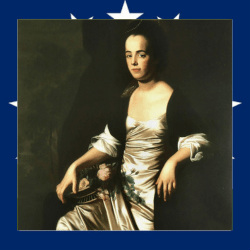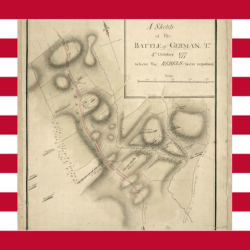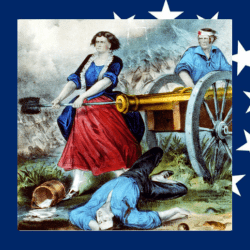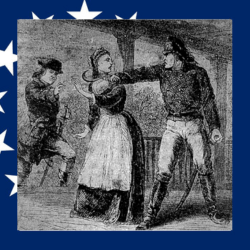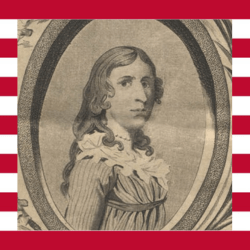Heroines of the American Revolution:
Quilt VIII
Every even year, Girl Museum celebrates Women’s History Month by presenting an exhibition of quilt squares that come together to make a patchwork of girls and women heroines contributed by our community. Some years we the quilts are themed to accompany major anniversaries or topics we are keen to explore.
This year we are showcasing Heroines of the American Revolution. These are girls and women who contributed in their own ways to the independence of the United States of America. But as always, this quilt is in honor of girls and their heroines everywhere.
You can scroll through the Quilt in order or select random pictures to reveal the story behind the heroine—the choice is yours, so enjoy and be inspired!
Who were the girls of the American Revolution?
The tumultuous years of 1750 to 1780 is a pivotal period in American history marked by revolution, resilience, and the redefinition of gender roles. From literary luminaries like Mercy Otis Warren to trailblazers such as Sybil Ludington and Deborah Sampson, in this exhibit, we explore how these courageous and resilient young heroines shaped history. We celebrate their contributions, honor their legacy, and try to uncover the often-overlooked narratives of girlhood during this transformative period in American history.
From 1750 to 1780, girls experienced life within the framework of colonial America, navigating the complexities of burgeoning societal expectations and evolving gender roles. In general, girls’ lives were primarily centered around family and domestic duties, reflecting the prevailing gender roles of the time. However, the tumult of the American Revolution brought about significant changes in the lives of girls and women. With men leaving to join the war effort, girls and women had to take their places in the fields and in business. This resulted in relatively more freedoms and opportunities after the war was over.
Like always, girlhood and womanhood were shaped by a complex interplay of societal norms, cultural practices, and economic conditions. Urban girls usually had more opportunities for education and social engagement, while rural girls were often more isolated and had greater responsibilities on family farms or in household chores.
Ethnicity also played a significant role, with Native American, African American, and European American girls experiencing vastly different social and cultural contexts. Native American girls, for instance, often participated in communal activities and played integral roles within their tribes, while African American girls faced the harsh realities of slavery and its attendant restrictions on education and autonomy.
In general, formal education for girls was limited compared to boys. However, there were some opportunities for girls to receive education, particularly in urban areas and among affluent families. In urban centers, girls from wealthier families might attend private academies, where they could learn basic literacy and numeracy skills, as well as subjects like needlework, music, and etiquette. These schools typically focused on preparing girls for their roles as wives and mothers. Additionally, some girls had access to education through church-sponsored schools or charity schools, which provided basic instruction to children from lower-income families.
However, in rural areas and among poorer families, formal education for girls was scarce. Schools were few and far between, and many girls received their education at home, learning practical skills from their mothers or other female relatives.
The American Revolution brought about significant changes in gender roles as women and girls were called upon to assume new responsibilities and roles traditionally reserved for men. One of the most common ways girls and women supported the revolution was through domestic activities such as managing households, farms, and businesses in the absence of their male relatives. Moreover, girls and women played vital roles as nurses, tending to the wounded and providing medical care to soldiers on both sides of the conflict. Some even actively participated in the war effort as spies, messengers, and even soldiers!
Questions to Consider
When you read through these heroines’ experiences and their lives, here are a few things to keep in mind and questions to ask yourself.
- How did society think girls should act during the American Revolution, and how did these heroines break those rules?
- Did people back then think these heroines were important? Why or why not?
- How are the challenges these heroines faced like the ones girls and women still face today?
- What lessons can we learn from these heroines’ experiences about the importance of diversity, inclusion, and representation in historical narratives?
Phillis Wheatley, First Black Poet
Frontispiece to her book, this engraving depicts Phillis Wheatley penning a poem. Image courtesy of the Library of Congress Rare Book and Special Collections Division. “Her poems provide a window into Black girls’ culture, slavery, and the emergence of abolitionism...
Judith Sargent Murray, Freedom Writer
Portrait of Judith Sargent Murray by John Singleton Copley, Terra Foundation for American Art, Daniel J. Terra Collection via Wikipedia. Judith Sargent Stevens Murray is prominently remembered for her essays and journalistic comments on women’s rights. Her works...
Agent 355, Unknown Heroine
1790 portrait of Major Benjamin Tallmadge with his son William, via Wikipedia. Agent 355 was a special code name during the American Revolution for an unknown female spy. Although there are well-known spies, Agent 355 was part of the Culper Ring spy network, a Long...
Sally St Clair, Disguised Heroine
Sally St Clair, the fallen maiden, via Wikipedia. Sally St. Clair (or St. Clare) was an American woman who disguised herself as a man and joined the Continental Army, as a South Carolina Regiment member. She marched and fought alongside men, and most likely also...
Elizabeth Freeman, Freedom for All
Portrait of Elizabeth Freeman, better known as ‘Mumbett’, via Wikipedia. Elizabeth Freeman, better known as ‘Mumbett’ or ‘Bett’ was born a slave and remained as one for nearly thirty years before she successfully sued for her freedom. The 1781, Brom & Bett v. J....
Sally New River, Catawba Heroine
The Catawba Tribe in 1913, nearly 100 years after the death of Sally New River, via WikiCommons. The American Revolution occurred between the mid-1760s and 1791, meaning that for years people living within the colonies had trouble understanding what direction their...
Mammy Kate, Enslaved Heroine
Fort Augusta, Pennsylvania; the fort that Mammy Kate rescued Steven Heard from, via Wikipedia. The lives of enslaved people, especially women, in United States history have often been intentionally erased by their enslavers to suppress their culture and their...
Betty Zane, Frontier Heroine
Betty Zane passing her retrieved supply of gunpowder to the Fort Henry defenders, via Wikipedia. Imagine running through an open fire of gunshots, clutching onto the supply of gunpowder in your hands for your dear life. Your clothes are pierced, but you are...
Mary Catherine Goddard, Revolutionary Newswoman
A print of the Declaration of Independence made and distributed by Mary Goddard, stamped with her name at the bottom, via WikiCommons. For decades, magazines and newspapers have promoted some incredible changes across the world. Just like today, a few words on a small...
Anna Marie Lane, First Female Soldier
A Revolutionary War era map of the Battle of Germantown. This is where Anna was tragically wounded. From the Library of Congress via WikiCommons. Women and girls have been invaluable during times of war or conflict for all of history, with their roles as nurses,...
Sarah Fulton, Mother of the Boston Tea Party
Memorial stone marker on the site of the home of Sarah Bradlee Fulton, active participant in the American Revolutionary War, via WikiCommons by Mmangan333. Women’s stories, like that of Sarah Fulton, are not always known as well as the men’s stories in the American...
Rebecca Brewton Motte, Sacrifice for Revolution
Portrait of Rebecca Brewton Motte, via WikiCommons. Born on June 15, 1737, Rebecca Brewton Motte was the daughter of Robert Brewton and Mary Loughton Brewton. She grew up in Charles Town (which would later be known as Charleston), South Carolina and was raised in a...
Jane Black Thomas, Fierce Heroine
Jane Black Thomas rides to Cedar Spring to alert the Rebel camp of an upcoming surprise ambush, via WikiTree. Born in 1720 to Robert and Annabelle Waters Black in Chester, Pennsylvania, almost little to none is known about Jane Black’s early life and family life prior...
Grace and Rachel Martin, Brave Sisters
A map of South Carolina and Georgia from the year 1750, before the American War of Independence. The Martin sisters lived in the central North-Western part of the colony during the war, via Wikipedia. In the pages of history, the incredible tale of Grace and Rachel...
Mary Ludwig Hayes, Water Girl
A painting of Molly Pitcher bravely manning a cannon during the Battle of Monmouth, Library of Congress Prints and Photographs Division via WikiCommons. Beginning during the American Revolutionary War and continuing through to today, there has been an elusive legend...
Mary Anna Gibbes, Brave Girl
Peaceful Retreat Plantation – Mrs. Robert Gibbes’ Place, John’s Island, SC by Charles Fraser, May 1797. Original in the National Gallery of Art, Washington D.C. Few records remain of the “Heroine of Stono,” but to begin we know that her name was Mary Anna Gibbes, and...
Martha Bratton, Clever Heroine
Martha Bratton and the British officer holding the hook to her neck. She was harshly interrogated and still refused to divulge any valuable information, via WikiCommons. For Martha Bratton, the Revolutionary War started with a bang. In a whirlwind of events, she ended...
Kate Moore Barry, Heroine of Cowpens
Kate Barry via Military Women's memorial on Facebook Meet Kate Moore (Margaret Catherine Moore Barry) a true American hero! She was born in 1752 on a plantation in South Carolina and was the oldest of ten children in her family. Being the oldest in such a large...
Penelope Barker, Protest Organizer
Portrait of Penelope from 1774, at the age of 46, via WikiCommons. What does it mean to be loyal to one’s beliefs, even when it is challenging? This question is particularly tough to answer After all, displaying your allegiance to one cause or another was incredibly...
Nanye’hi, Cherokee Peacemaker
Photo of Nanye’hi’s tomb in Tennessee honoring her life as a “constant friend of the American Pioneer”, via WikiCommons. Growing up as an indigenous person in wartime America was incredibly tough. Not only did the people witness the battle for American independence,...
Patience Wright, American Wax Sculptor and Spy
Painting of Patience Wright by Robert Edge Pine, via WikiCommons. Unfortunately, reflection on famous female artists pre-1960 yields quite limited results. For many centuries, art was considered to be a “man’s profession,” and while there were women who engaged in the...
Lydia Darragh, Super Spy
Painted portrait of middle-aged Lydia Darragh in a bonnet, artist unknown, via WikiCommons When people imagine spies today, they typically envision sauve agents, decked out in the most innovative gadgets their time could offer or dressed up in an outfit that perfectly...
Prudence Cummings Wright, Minutewoman
A modern bridge in Pepperell Massachusetts, approximately where the minutewoman ambushed the British, via WikiCommons. The word “prudent” means to be cautious and careful, and in turn the name “Prudence” intends to invoke the same characteristics in the woman to whom...
Deborah Sampson, Soldier Girl
Portrait of Deborah Sampson done in 1797 by Herman Mann, via Wikipedia. How many female soldiers do you know? Chances are, even if you have never met one personally, you have probably seen some women in the military within your lifetime. While it is normal for women...
Margaret Cochran Corbin, Camp Heroine
Plaque in Manhattan’s Fort Tryon Park remembering Margaret's bravery and fighting spirit. “Molly Pitcher” is a legend heard by many Americans growing up, and often used as a blanket term to describe the elusive women who fought in battle during the Revolutionary War....
Esther DeBerdt Reed, Founder of The Ladies of Philadelphia
Portrait of Esther, via WikiCommons. During the time surrounding the Revolutionary War, women often found themselves relegated to the private sphere, meaning that much of their accepted work and socializing took place within the home and their public presence was...
Mercy Otis Warren, American Conscience
A portrait of Mercy Otis Warren posing from 1763, via Wikipedia. Mercy Otis Warren was a leading political and literary figure during the American Revolution. Known as the “Conscience of the American Revolution,” Mercy became an outspoken figure for women’s access to...
Lucy Knox, Family Traitor
Portrait of Lucy’s daughter bearing the same name, Lucy Flucker Knox Thatcher, via Wikipedia. The Revolution divided families and communities based on loyalty to the crown. At the age of 14, Lucy Flucker Knox joined the ranks of traitors - abandoning her family’s...
Sybil Ludington, Midnight Rider
Statue of Sybil Ludington on Gleneida Avenue in Carmel, New York by Anna Hyatt Huntington, via Wikipedia It was a dark night in April 1777, about 9 p.m. The American Revolution was taking over the country, pitting neighbor against neighbor. In Putnam County, New York,...



